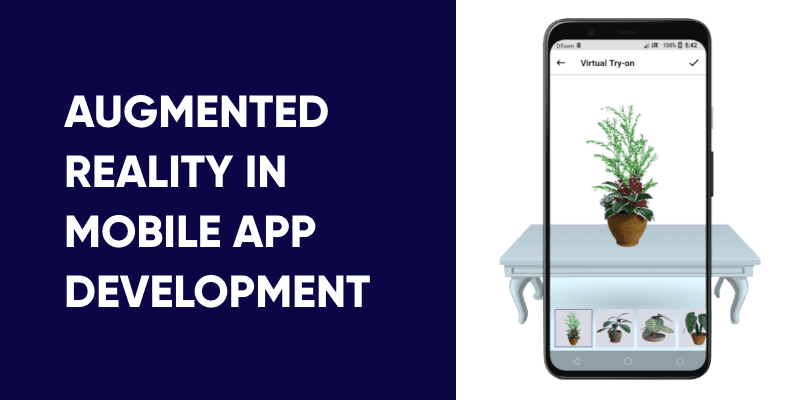Augmented Reality is growing rapidly and on the verge of exploding. The demand for AR VR app development has risen as a result of this trend. The majority of mobile app development companies are including augmented and virtual reality in their services.
Every business owner has certain questions in their mind like how AR apps are developed, what is the future of AR, etc. As AR devices are being developed by companies in a variety of areas, including healthcare, media and entertainment, e-commerce, and more. The high volume of AR devices on the market has boosted the future scope of mobile app development, allowing app development companies to do more with mobile apps for various devices.
The use of augmented reality in business has revolutionized the way things are done. It has narrowed the gap in product reliability, particularly in -commerce, by allowing users to verify things more creatively.
Many industries, including healthcare, fashion, manufacturing, gaming, and entertainment, are taking advantage of the benefits of augmented reality. People can now see things more clearly than previously and communicate more successfully with business providers using their cellphones.
This blog covers all the major parameters like what augmented reality applications are and how they are broadening the field of mobile app development, what you should know before developing an AR-based mobile app, the cost of creating AR-based mobile applications, and how AR apps are changing the way people do business today, and much more.
What Is Augmented Reality?
AR apps will alter our perception of the world. These are software applications that combine digital content with real-world experience. The concept of virtual reality and augmented reality is totally different. Virtual elements are blended with actual people in augmented reality, whereas the entire experience is presented as a simulation in virtual reality. Unlike virtual reality (VR), no additional equipment such as headsets, goggles, or other devices is required. You’ll need your device’s camera as well as an augmented reality app.
For example, Pokemon Go drew worldwide attention, prompting AR brand collaborations from companies like Starbucks and T-Mobile. It’s a mobile game developed and released by Niantic for iOS and Android smartphones that have set world records for downloads and app revenue. According to Apptopia, Pokémon Go was published in 2016 and had 900 million downloads and $1.2 billion in revenue as of September 2018.
However, Pokemon Go is far from the only notable augmented reality player on the market. According to experts interviewed by the BBC, current market value estimations suggest it may be as high as $162 billion in 2024. AR device and service revenue is currently over $54 billion and is rapidly increasing.
How Does Augmented Reality Work With Mobile App Development?
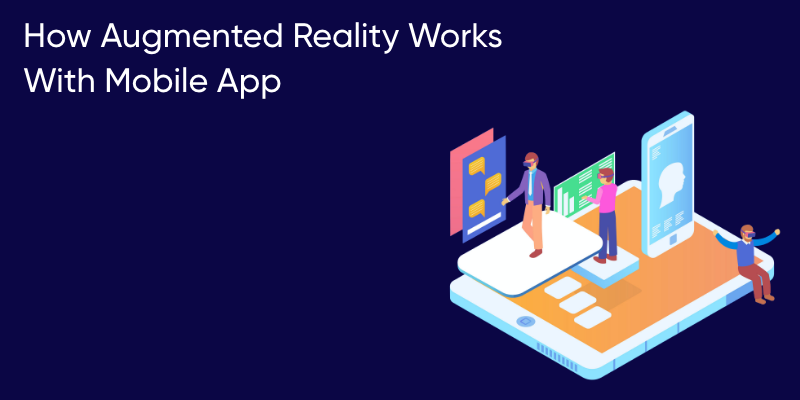
Integrating augmented reality (AR) in applications increases customer engagement and experience. You’re undoubtedly thinking about how you can include augmented reality into your app brand with all the buzz and enthusiasm around this technology. When moving forward with an AR project, there are a few general development phases to consider.
Select the AR elements you want to use:
Augmented reality entails the integration of digital items into the physical world. You must consider how to integrate AR mobile app. This may include adding informational facts to different areas using GPS, or the app showing internal anatomy when the camera is focused on a specific body part. It’s up to you to pick what kind of augmented reality functionality you would like in your application.
Determine how you want to integrate augmented reality elements:
This entails selecting the appropriate AR platform for development, such as ARKit or ARCore, based on the device you intend to use.
What will the user’s experience with the AR app be like?
This includes whether users will receive push notifications, how they will start the AR features in the app (voice activation, tapping a button, etc.), and whether the augmented reality functionality will require some form of anchor or QR code as a reference point.
Choose an AR category:
There are four different AR categories from which to choose. You can pick between marker-based, markerless/location-based, projection-based, or superimposition-based augmented reality. You must decide which AR aspects you want to include as well as how you want your users to interact with and experience your app.
Wearable support:
Will your application be able to link to augmented reality hardware such as smart glasses? Do you want your users to be able to interact with your product without having to use their hands?
What You Must Know Before Creating A Mobile App Using AR Technology?
Augmented Reality is not the same as virtual reality (VR). Unlike VR, which is immersive and necessitates a headset like the Oculus Rift, AR allows app developers and businesses to add digital information to real-world objects. You can rent a walking guide in museums and galleries all over the world – usually on a device the size of an old phone or Walkman, with headphones.
Consider what would happen if you instead downloaded an app and pointed it to displays to acquire more information. When you have a product or service that would benefit from a digital overlay of new and intriguing information that is the type of immersive experience your firm may deliver to customers with Augmented Reality. AR is already affecting app development throughout the world, with organizations in industries as diverse as real estate, banking, and healthcare requesting AR layering and augmentation in their apps.
Unlike virtual reality, augmented reality is more accessible and does not necessitate the purchase of new equipment. AR technology is accessible to anyone who owns a smartphone with a camera. Location-based services can be useful, but they aren’t required. There are two forms of AR that organizations can supply if they want to include it in or alongside their mobile offerings.
Location-based AR
Marker-based apps rely on patterns and interaction with a smartphone camera rather than geographic data. When a smartphone’s camera is pointed at a QR code containing a logo or brand symbol, for example, a digital overlay of information in the real world is generated when the app is accessed.
Marketers have a lot of opportunities with marker-based information overlays. Digital marketing and point-of-sale can now be combined with physical promotions and in-store/on-site events. When these elements are combined, they create a powerful and effective game-changer. Even if the object in question is animated, this approach is useful.
Adding a user interface overlay to a physical object, such as a piece of clothing or a restaurant meal, allows marketers to think of new ways to make an in-store experience more immersive, resulting in improved customer satisfaction and more revenue.
Marker-based AR
Will your application be able to link to augmented reality hardware such as smart glasses? Do you want your users to be able to interact with your product without having to use their hands?
The Amalgamation Of AR And Mobile App Development
Here are some sectors that are integrating AR technology in their applications. Let’s have a look at them in detail.
Travel Apps
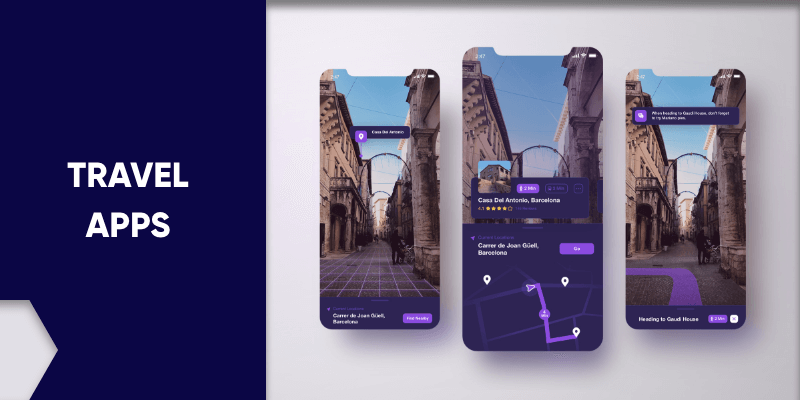
Augmented reality (AR) in travel apps to achieve more traction in their business. You can more simply show users the destinations available as part of the sales process. Increasing the ease with which a city, region, or resort can be sold. When you arrive at your location, AR apps can provide more information and an immersive experience that will improve the quality of your vacation. Several apps currently integrate augmented reality into the tourist experience.
Real-estate Apps
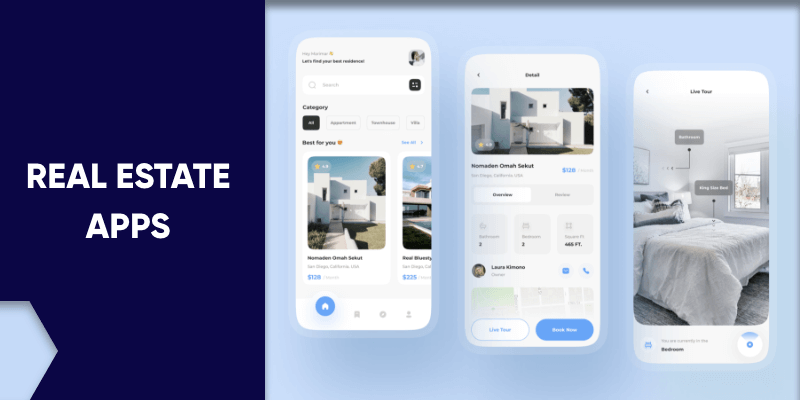
You can create some of the best real estate apps with the use of AR. Several real estate home tour mobile apps, such as Smart2VR and Realvision, use AR to digitally modify the property’s interior or exterior in a process known as “virtual staging.” Decorative items, furniture, and plants are all useful in staging. This allows a potential buyer to see what’s feasible for a property that could be difficult to sell otherwise due to outdated décor or a lack of furnishings.
Educational or E-learning App
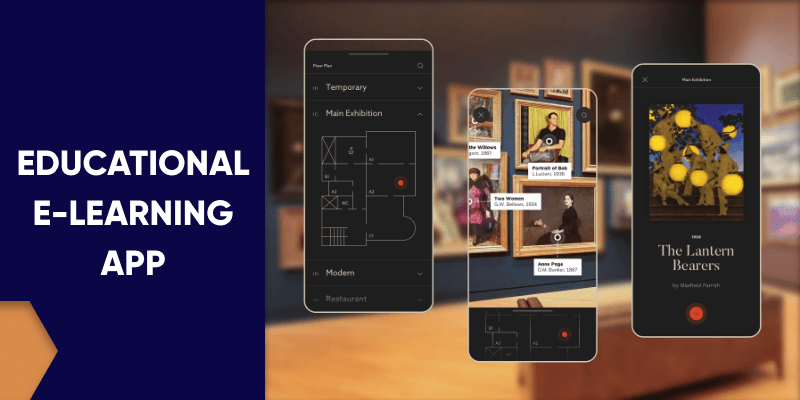
Immersive learning experiences for students of all ages are possible. Students already use smartphones and tablets to access learning tools and e-learning apps, making an AR experience a short step along a well-traveled path. Augmented reality tools for education has the potential to greatly boost the education sector since educators will be able to deliver information that kids will embrace more readily than traditional learning techniques.
Healthcare Apps
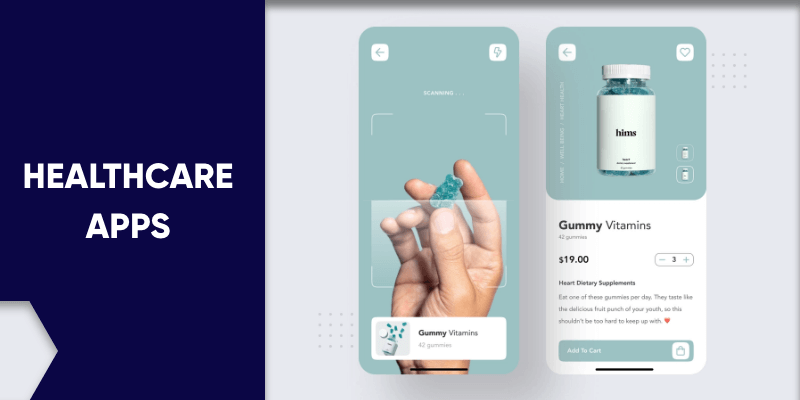
The use of augmented reality in healthcare app development has opened up a world of possibilities. AR can assist doctors in accurately diagnosing and treating patients. They can execute functions better than previously now that they have access to real-time patient data. AR glasses aren’t the only way to use augmented reality in healthcare. Physicians are now successfully employing AR during interventional treatments. The visualization paths of Computerized Tomography (CT) and Magnetic Resonance Imaging (MRI) are two examples.
Fitness Apps
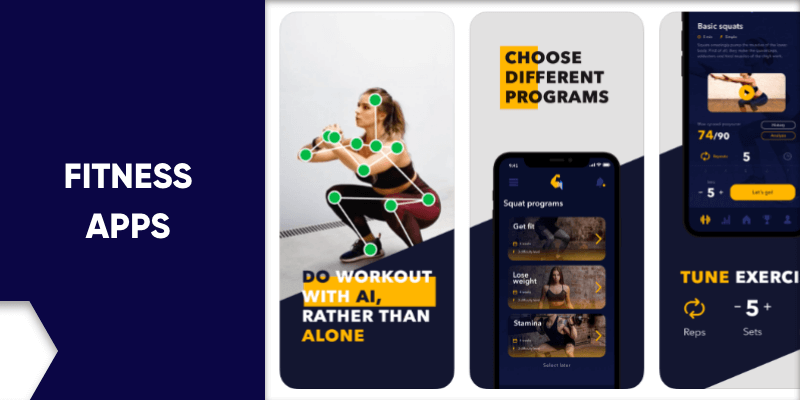
In today’s fitness business, augmented reality has become a prominent technology. It is changing the dynamics of people’s physical exercise by giving a real-life experience that is more engaging and enjoyable. In the fitness sector, augmented reality is quickly becoming everyone’s go-to method of working out. With augmented reality, you can digitally Livestream and work out with others while staying safe and comfortable at home.
Gaming App
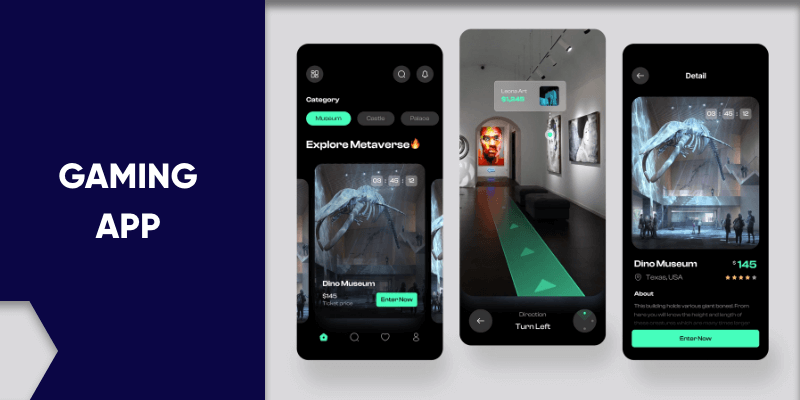
The gaming industry, machine learning, and computer vision have been game-changers. Together, these two technologies, together with virtual reality, have altered the gaming landscape by making it more engaging and adding more enjoyable features. They work together to provide gamers with exceptional gaming experiences. This has had a good impact on gaming provider businesses as well. Using these technologies, they can better retain players and sell more AR gaming products. That’s why, according to studies, the global market for virtual reality is will reach USD 45.09 billion by 2025.
How To Develop AR Based Mobile Apps?
Augmented reality apps depend on various elements, including the ability to determine if the AR integration is location or marker-based, as well as some type of picture processing. A virtual reality program will nearly always superimpose digital content over a real-world object in real-time. One of the most difficult aspects of designing an AR application is aligning physical and digital content.
One of the most difficult aspects of this task is ensuring that the UI/UX is perfectly customized to the demands of the user; otherwise, the app may not provide much value to those that download it. Maintain a basic and straightforward AR experience. People will avoid using it because of its clumsy nature.
So, how does developing of AR happen? AR app creation necessitates a unique set of abilities that are rarely seen in mobile development teams. Although you will need to collaborate with mobile app developers, you will also want competence in 3D modeling, computer vision, and imaging. One or more expert designers/developers will be required to provide such talents while collaborating with app developers to integrate AR elements into a new or modified app.
To keep things simple for other app developers working on the project, most augmented reality app development projects are written in C# or C++. Thankfully, developers working on AR projects can rely on trustworthy platforms to generate AR objects and take advantage of a variety of useful tools that cut down on development time.
Assuming that augmented reality can improve consumer interactions and revenue, let’s look at how much it costs to design and implement AR in an app.
Cost Of Building An AR-Based Mobile App
Although there are various possibilities for adopting AR technology, here are three of the most popular methods and how much they cost when working with an Eastern European development team.
Basic ‘gyroscope’ implementation
Consider an app that doesn’t use augmented reality. Add a gyroscope format feature that uses a smartphone’s camera to position digital or 3D objects around the user. This is one of the simplest and fastest ways to include augmented reality into your app.
Based on the premise that a developer in Ukraine can perform this at around $35.00 per hour, this work may take between 150 and 250 hours.
Estimated cost: $5250 – $8750
SLAM (Simultaneous Localization and Mapping)
Multiple sensors on a device or in a specific region helps to pinpoint an object’s exact location. You can combine SLAM with an AR application to precisely locate a 3D object in a new location, which Ikea and other furniture dealers find beneficial.
This type of work can take anywhere from 250 to 500 hours, depending on the complexity of the products involved.
Estimated cost: $8750 – $17,500
Location-based AR
One of the most popular formats also necessitates a significant amount of effort and the use of numerous technologies. In order to construct a location-based AR app, you’ll need to use GPS, Wi-Fi, and a compass, as well as 3D tools and digital content creation. This could take anywhere from 400 to 800 hours.
Estimated cost: $14,000 – $28,000
What Is The Future Of AR In App Development?
AR apps are being used by users in greater numbers than ever before. As a developing technology, businesses are embracing augmented reality. AR is assisting mobile app development enterprises and businesses in elevating their user experience to new heights.
AR is a dazzling technology that has the potential to change smartphones. And tablets by adding new functionality to mobile apps.
Google and Apple have already established themselves as industry leaders and are embracing the benefits of augmented reality. Furthermore, people want more businesses to offer exceptional AR applications.
If you have some fantastic app ideas, now is the time to start working on AR app development to attract more clients and increase your company’s revenue.
AR outsourcing is a great option to get highly professional and cost-effective AR apps for your business. So, if you want to design an augmented reality mobile app, contact Echoinnovate IT, one of the best mobile app development companies across the world, with offices in Toronto, Canada. You can hire AR offshore developers from our company who are well-versed in mobile app development in Toronto. We’ve had the opportunity to experiment with augmented reality from its beginnings, and as a result, we have a great deal of experience with it. Get in touch with our experts now to take your business to the next level with AR technology.
FAQs
What are the benefits of augmented reality?
AR increases engagement and interaction and provides a richer user experience. AR increases the perceived value of products and brands. Well-implemented AR activity conveys innovation and responsiveness from forward-thinking brands.
What is augmented reality app development?
Augmented reality app development focuses on 3D model design. And algorithm implementation, which is responsible for overlaying virtual content over the scene in the device’s camera lens.
How long does it take to create an AR app?
It might take 1-3 months for developing an AR-based app. The time may vary depending on several factors such as features, the complexity of your application, etc.
